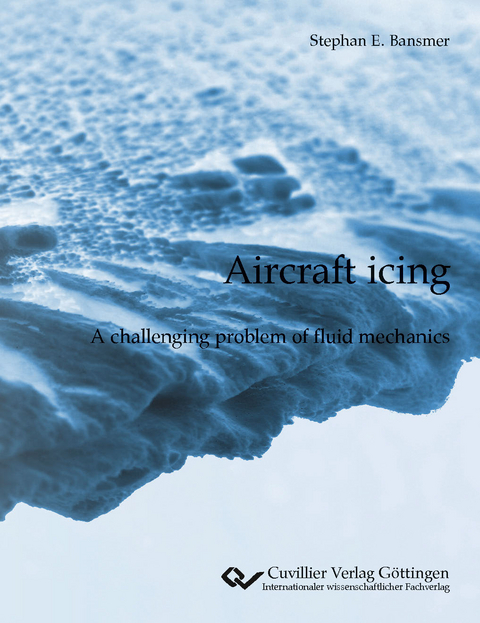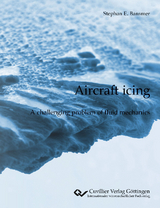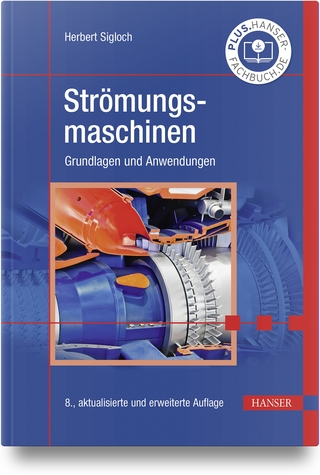Aircraft icing
A challenging problem of fluid mechanics.
Seiten
2020
Cuvillier Verlag
978-3-7369-7224-7 (ISBN)
Cuvillier Verlag
978-3-7369-7224-7 (ISBN)
- Keine Verlagsinformationen verfügbar
- Artikel merken
In 2018, approximately 4.3 billion passengers were carried by scheduled flights in the member states of the International Civil Aviation Organization. To satisfy the needs of day and night flight operations even in situations of inclement weather, aircraft icing is an inherent component of the certification of large transport aircraft. Ice detection and protection systems ensure flight safety and must be designed carefully. The reliable prediction of ice accretion is a mandatory intermediate step that involves many challenging problems of fluid mechanics that will be treated in this volume. After introducing the topic of aircraft icing with a brief historical overview of technological and scientific progress over the last century, current challenges from the perspective of fluid mechanics are outlined. In particular, the governing boundary conditions of the phenomenon are highlighted, accompanied by remarks on non-dimensional groups and scaling laws. Selected physical properties of water and ice are elucidated. Classic ice accretion is usually triggered by the impact of supercooled droplets on a surface. After analysing the solidification process of supercooled water, drop impact is studied on both dry and wetted substrates. Macroscopic phenomena of ice accretion are considered using a combined approach of experiments and computations. To carry out experimental investigations, the Braunschweig Icing Wind Tunnel was built. Together with the results of the icing code TAUICE, the gathered data are used to develop a deeper understanding of the process of glaze ice accretion, which involves a broad range of physical phenomena, including wetting, roughness formation, transitional flow and heat transfer.
| Erscheinungsdatum | 07.08.2020 |
|---|---|
| Verlagsort | Göttingen |
| Sprache | englisch |
| Maße | 205 x 265 mm |
| Themenwelt | Naturwissenschaften ► Physik / Astronomie ► Strömungsmechanik |
| Naturwissenschaften ► Physik / Astronomie ► Thermodynamik | |
| Technik ► Maschinenbau | |
| Schlagworte | acceleration vector • Aircraft Icing • airframer perspectives • Benetzung • Boltzmann constant • Boltzmann-Konstante • Braunschweiger Mehrphasen- und Vereisungswindkanal • Braunschweig Icing Wind Tunnel • Brennweite • camera coordinate • catch efficiency • certification of large transport aircraft • drag coefficient • Dreiecksmatrix • Drop impact • Eisakkumulation • Eisansatz • Erstarrung • Erstarrungsvorgang • Euler’s number • Feuchtigkeit • flight safety • Flugsicherheit • fluid mechanics • Flüssigwassergehalt • focal length • force • free energy • Gefrieren • glaze ice accretion • gravitational acceleration • Gravitationsbeschleunigung • heat transfer • ice accretion • icing code TAUICE • inclement weather • Kamerakoordinate • Klareis • Kraft • Latente Schmelzwärme • Latent Heat of Fusion • Latent heat of sublimation • Lift coefficient • Linienflug • liquid films • Liquid water content • Molekulare Masse • Nachtflug • Rauheitsbildung • Rauhigkeitsbildung • Regelvolumen • Relative humidity • roughness formation • Scaling laws • Skalierungsgesetze • Skin-friction coefficient • solidification • Specific enthalpy • Splashing • static pressure • Steuerfläche • Strömungsmechanik • Sublimationswärme • supercooled droplets • thermal conductivity coefficient • Transitional Flow • Transition laminar-turbulent • Triangular Matrix • Tropfenaufprall • Turbulence level • Turbulenzgrad • unterkühlte Tropfen • Vereisungscode TAUICE • Vereisungswindkanal • Vereisung von Flugzeugen • Wärmeleitfähigkeit • Wärmeübertragung • Wetting • Zertifizierung von Verkehrsflugzeugen |
| ISBN-10 | 3-7369-7224-5 / 3736972245 |
| ISBN-13 | 978-3-7369-7224-7 / 9783736972247 |
| Zustand | Neuware |
| Informationen gemäß Produktsicherheitsverordnung (GPSR) | |
| Haben Sie eine Frage zum Produkt? |
Mehr entdecken
aus dem Bereich
aus dem Bereich
Wirbel, Zirkulation, Auftrieb
Buch | Softcover (2024)
De Gruyter Oldenbourg (Verlag)
44,95 €




